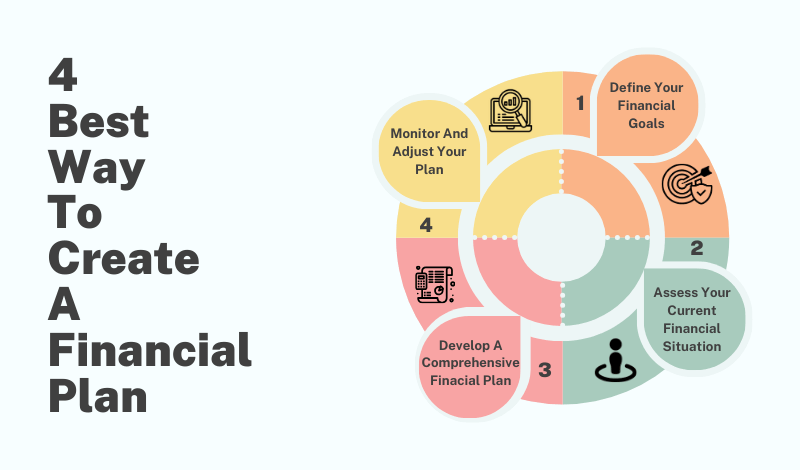Crafting Your Financial Blueprint: Financial Plan
In today’s ever-changing economic landscape, having a well-crafted Financial Plan is essential for achieving long-term financial security and meeting your life goals. A comprehensive Financial Plan serves as a roadmap, guiding you through various financial decisions and helping you navigate the complexities of managing your money effectively. Whether you’re just starting your financial journey or seeking to refine your existing strategies, this guide will provide you with the 4 best ways to create a Financial Plan and the best practices for creating a robust Financial Plan tailored to your unique needs.
1. Define Your Financial Goals:
The first step in creating a financial plan is to clearly define your goals. These goals can range from short-term objectives, such as saving for a down payment on a home or building an emergency fund, to long-term aspirations, like retirement planning or funding a child’s education.
Prioritize Your Goals
Not all goals carry equal weight, and it’s essential to prioritize them based on their urgency and importance. Categorize your goals into short-term, medium-term, and long-term objectives, and rank them accordingly.
Make Your Goals S.M.A.R.T.
Ensure that your goals are Specific, Measurable, Attainable, Relevant, and Time-bound (S.M.A.R.T.). This approach will help you set clear, actionable, and realistic targets, increasing the likelihood of achieving them.
2. Assess Your Current Financial Situation:
Before you can create an effective financial plan, it’s crucial to have a comprehensive understanding of your current financial situation. This includes:
Income and Expenses
Evaluate your sources of income, including employment, investments, and any other revenue streams. Additionally, track your monthly expenses, categorizing them into fixed and variable costs to identify areas for potential savings.
Assets and Liabilities
Take inventory of your assets, such as savings accounts, investments, and property, as well as your liabilities, including debts, loans, and mortgages. This will provide you with a clear picture of your net worth.
Risk Tolerance and Investment Profile
Determine your risk tolerance and investment profile. This will guide your investment decisions and help you allocate your assets appropriately based on your financial goals, time horizon, and comfort level with risk.
3. Develop a Comprehensive Financial Plan:
With your goals and current financial situation in mind, it’s time to develop a comprehensive financial plan. This plan should encompass various aspects of your financial life, including:
Budget and Cash Flow Management
Create a realistic budget that aligns with your income and expenses. Identify areas where you can reduce unnecessary spending and allocate funds towards achieving your financial goals.
Debt Management
Develop a strategy to manage and eliminate existing debts, such as credit card balances, student loans, or mortgages. Prioritize high-interest debts and consider debt consolidation or refinancing options if applicable.
Savings and Investment Strategies
Establish a savings plan that aligns with your short-term and long-term goals. Additionally, create an investment strategy that considers your risk tolerance, time horizon, and diversification needs. Consider consulting with a financial advisor for guidance on appropriate investment vehicles.
Retirement Planning
Determine your retirement income needs and develop a plan to fund your desired lifestyle. Consider contributing to tax-advantaged retirement accounts, such as 401(k)s or Individual Retirement Accounts (IRAs), and explore options for Social Security benefits and other potential income sources.
Insurance and Risk Management
Evaluate your insurance needs, including life, health, disability, and property insurance. Ensure that you have adequate coverage to protect yourself and your loved ones from potential financial risks.
Estate Planning
Develop an estate plan that outlines your wishes for the distribution of your assets and minimizes the potential for legal complications or family disputes. This may involve creating a will, establishing trusts, and designating beneficiaries.
4. Monitor and Adjust Your Plan:
A financial plan is not a static document; it should be regularly reviewed and adjusted to reflect changes in your personal circumstances, financial goals, or economic conditions.
Conduct Regular Reviews
Schedule periodic reviews of your financial plan, ideally on an annual basis or whenever significant life events occur, such as marriage, birth of a child, job change, or inheritance.
Stay Disciplined and Flexible
Remain disciplined in following your financial plan, but also be flexible enough to adapt to changing circumstances. Adjust your strategies as needed to ensure that your plan remains relevant and effective.
Seek Professional Guidance
Consider working with a qualified financial advisor or planner, especially if you have complex financial situations or require specialized expertise. A professional can provide objective guidance, identify potential blind spots, and help you navigate the intricacies of financial planning.
Creating a comprehensive financial plan is a crucial step towards achieving financial security and realizing your life goals. By following these best practices, you can develop a personalized roadmap that considers your unique circumstances, goals, and risk tolerance. Remember, financial planning is an ongoing process that requires regular monitoring and adjustments to ensure you stay on track and make the most of your financial resources.











